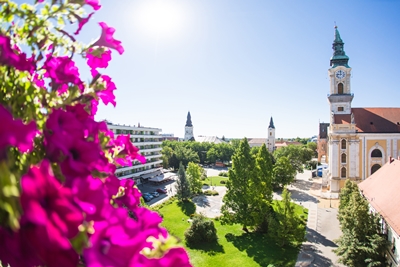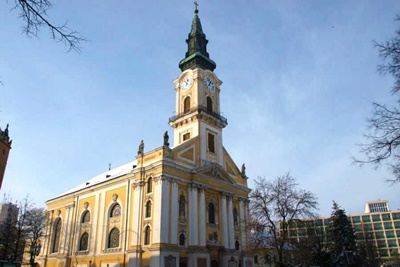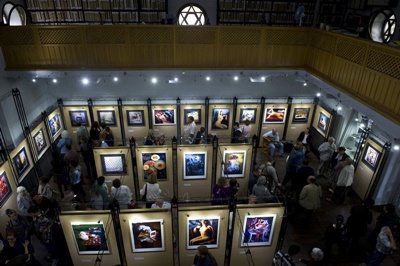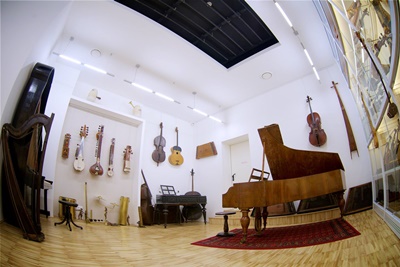 Kecskemét is the seat of Bács-Kiskun county and Kecskemét district. It is situated in the middle of Hungary, on the sandy plain between the Danube and the Tisza, 86 kilometres south of Budapest.
Kecskemét is the seat of Bács-Kiskun county and Kecskemét district. It is situated in the middle of Hungary, on the sandy plain between the Danube and the Tisza, 86 kilometres south of Budapest.
Kecskemét was founded at the crossroads of ancient trade routes, mentioned as a farming town in a charter of King Nagy Lajos in 1368. Since 1950, Kecskemét has been the seat of Bács-Kiskun County, which is also known as the "Famous Town".
For the full experience, we've collected a few Kecskemét attractions that are definitely worth a visit during your stay.
 In the main square of Kecskemét is the Catholic Great Church, the largest late Baroque cathedral in the Great Plain. The church was built between 1774-1806 according to the plans of Gáspár Oswald, and since 1993 it has been the co-cathedral of the Kalocsa-Kecskemét Archdiocese.
In the main square of Kecskemét is the Catholic Great Church, the largest late Baroque cathedral in the Great Plain. The church was built between 1774-1806 according to the plans of Gáspár Oswald, and since 1993 it has been the co-cathedral of the Kalocsa-Kecskemét Archdiocese. The building's tower is 73 metres high, its dome is 12.5 metres in diameter and its 2.5-tonne bell once echoed all the way to Bugac. The church now has 3 bells, but before the First World War it had 6. The bell has a particularly rich history. The 'big bell of the Old Church of Kecskemét', mentioned in the song, melted down in a fire on 2 April 1819. To commemorate this event, the bells of Kecskemét are rung every year on 2 April from 8:30 to 9:30 in the evening. On its exterior is an inscription in Latin, which reads in Hungarian: "When, on that mournful night of 2 April, this church and most of the city were burnt down in the fire, I was also injured. The council and the Roman Catholic people of Kecskemét, which I had delighted with my pleasant voice since 1694 - since the calamity had first damaged it in 1819 and then again twenty-nine years later - had it enlarged and re-cast in 1852 in honour of the Holy Trinity, when the favourable turn of fortune came. The tower is surrounded by a balcony from which the fire was once watched.
 The Kecskemét Cifrapalota was built in the Art Nouveau style at the junction of Rákóczi út and Szabadság tér, in 1902, based on the plans of Géza Márkus. The building was once used as apartments, shops and a commercial casino.
The Kecskemét Cifrapalota was built in the Art Nouveau style at the junction of Rákóczi út and Szabadság tér, in 1902, based on the plans of Géza Márkus. The building was once used as apartments, shops and a commercial casino. The almost 50-year-old Wildlife Garden has been developing dynamically since 2000. Its small area is home to a rich collection of animals: 500 specimens of 120 species, all iconic animals. The walks can be planned as a 1-2 hour programme, in shady woodland, on an accessible route, and are comfortable.
The Kecskemét Wildlife Garden is a family-friendly, popular community space and meeting point.
 The building was built between 1895 and 1896 to commemorate the country's millennial anniversary and was originally called the Municipal Theatre. It was named after the author of Bánk bán, who was born and lived here, József Katona, twenty years later, in November 1916.
The building was built between 1895 and 1896 to commemorate the country's millennial anniversary and was originally called the Municipal Theatre. It was named after the author of Bánk bán, who was born and lived here, József Katona, twenty years later, in November 1916. The Hungarian Museum of Photography is Hungary's first museum dedicated to the presentation of photography and photographic art, as well as the first museum in Hungary to be maintained by a foundation. It was opened in Kecskemét in 1991. It is maintained by the Hungarian Photography Foundation.
The Hungarian Museum of Photography is Hungary's first museum dedicated to the presentation of photography and photographic art, as well as the first museum in Hungary to be maintained by a foundation. It was opened in Kecskemét in 1991. It is maintained by the Hungarian Photography Foundation. The Leskowsky Instrument Collection is the country's only collection of musical instruments open to the public. With over 2,000 pieces, the collection presents classical, folk and experimental instruments from the Middle Ages to the present day. Visitors can hear string, wind and percussion instruments from five continents. All visitors are offered expert personal guided tours in Hungarian and English. You can touch the instruments, play them without any musical training, experience the birth of sounds, try instruments you have never tried before, and gain a unique musical experience and valuable knowledge.
The Leskowsky Instrument Collection is the country's only collection of musical instruments open to the public. With over 2,000 pieces, the collection presents classical, folk and experimental instruments from the Middle Ages to the present day. Visitors can hear string, wind and percussion instruments from five continents. All visitors are offered expert personal guided tours in Hungarian and English. You can touch the instruments, play them without any musical training, experience the birth of sounds, try instruments you have never tried before, and gain a unique musical experience and valuable knowledge.
